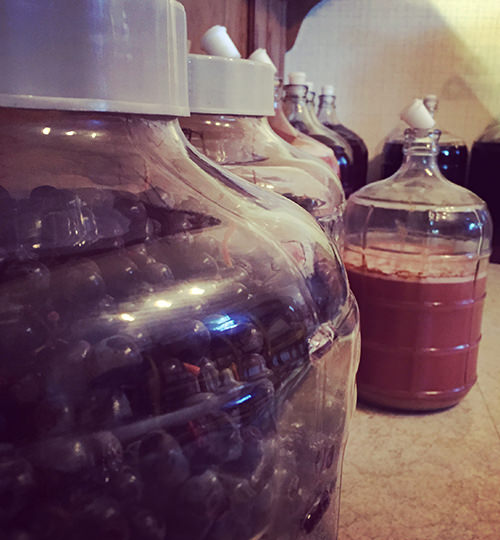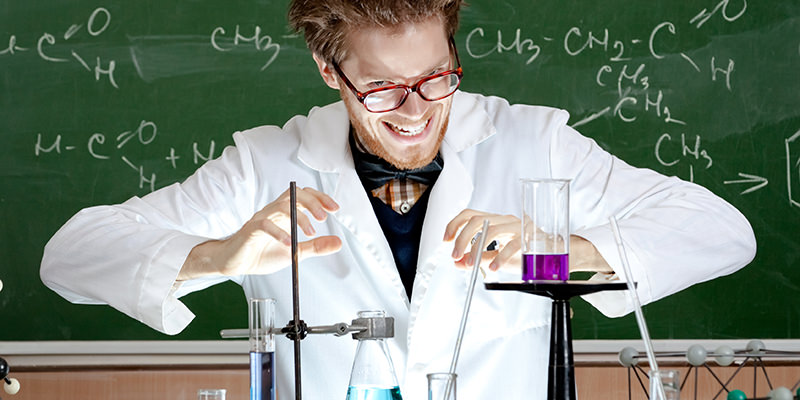Making wine is easy: crush some grapes and add a little yeast. Yeast eats sugar, releases alcohol and voilà, you have wine!
Making drinkable wine, however, requires either incredible luck or some serious science, and involves a bizarre collection of potion-testing tools you might expect to see Uncle Fester using in the basement of the Addams Family mansion. And making drinkable wine at home (in my household, we use the spare bathroom) only further reinforces how nutty and wizardry-esque winemaking can be. I never expected my bathroom to become a potions chamber filled with turkey basters and graduated cylinders for six weeks every year. Turns out that crafting vinous love in bathtub-sized batches takes some true mad science.
Before all else comes the crushing, or stomping of fruit, which can be done in any vessel large enough for a foot, from a bathtub to simple 5-gallon buckets. Once the magic of initial fermentation starts—sending out a welcome beacon to fruit flies everywhere—the focus switches to testing and tinkering for winemakers.
First and most frequently are tests measuring the speed and steadiness of the fizzy, bubbly, occasionally-overflowing fermentations, done with a bizarre gadget known as a hydrometer. Like a mercury thermometer with an extra large bulb on one end, the hydrometer bounces in a cylinder of wine, revealing how much sugar remains in the juice. Changes in this number tell winemakers how quickly, steadily, or sluggishly the fermentation is going, all of which affect the flavors and aromas of a final wine. Sometimes, it’s easy to accelerate a lethargic fermentation or slow down a speedy one: move the vessels into a sunny area or a cooler one. (Sometimes, it’s not so easy and might require a Super Yeast, but let’s not go there.)
As with any science experiment, things go wrong. Among these wine faults is Volatile Acidity, which smells and tastes as scary as it sounds, and is perhaps the worst. VA is an unsavory acid that often perks up in home fermentations, turning red wine into red wine vinegar or making vino smell like nail polish remover in the best case. Caused by high levels of ethyl acetate and acetic acid, which are natural in microscopic amounts, VA is pungent and difficult to remove because the bacteria responsible for it can live anywhere. In large wineries, reverse osmosis is the solution, equivalent to Harry Potter’s transfiguration class. In short, the VA-clouded wine is moved from tank or barrel to a series of cylinders where the juice spins rapidly and separates into its constituent parts—water, acids, alcohol—and is then built back together without the volatile compounds. Unless Amazon has started selling these massive, complex chemistry machines, reverse osmosis isn’t a solution for home winemakers. Instead, smelling fermentations is a constant, and so is dumping bad fermentations as far away as possible.
 Carbonic maceration is one vinous experiment that doesn’t require any fancy equipment at all. This ancient practice, made famous by the bubblegum-scented reds of Beaujoulais, literally ferments grapes from the inside out. At home, carbonic maceration happens by filling a wide-mouth jug (known on Amazon as the Big Mouth Bubbler) with whole clusters of grapes, and a touch of grape juice. Seal off the tank, and pressure begins building as fermentation kicks off in the juice and inside the berries. Over the course of a few days, grape skins burst sending streams of deep purple juice into the tank. And yes, the mixture does end up looking like horror movie blood and guts.
Carbonic maceration is one vinous experiment that doesn’t require any fancy equipment at all. This ancient practice, made famous by the bubblegum-scented reds of Beaujoulais, literally ferments grapes from the inside out. At home, carbonic maceration happens by filling a wide-mouth jug (known on Amazon as the Big Mouth Bubbler) with whole clusters of grapes, and a touch of grape juice. Seal off the tank, and pressure begins building as fermentation kicks off in the juice and inside the berries. Over the course of a few days, grape skins burst sending streams of deep purple juice into the tank. And yes, the mixture does end up looking like horror movie blood and guts.
Chromatography, the color changing group of tests that separate mixtures, tells home winemakers the Ph of their wines, as well as the status of malolactic fermentation, another elusive and silent winemaking process. This secondary fermentation changes tangy malic acid into smooth lactic acid, which gives Chardonnays their creamy taste, and Merlot its signature velvety mouthfeel. In the bathroom laboratory, detecting this fermentation requires stealing a wine sample, and slowly dropping it onto chromatography paper in hopes of a changing color. If malolactic fermentation hasn’t begun spontaneously, there’s a magic trick for that too. Packets of mysterious powder, specifically lactobacillus bacteria, sprinkled into the wine will jumpstart the process, as will adding a a few turkey baster’s worth of wine that already contains this strain of bacteria.
Dry or sweet, fizzy or still, winemaking truly is a mad science game. The real magic however, is that there’s a potion or powder for every ailment, down to coloring agents and sluggish fermentations. This year, instead of dressing as a chemist or a wizard for halloween, you could simply go as a winemaker, hissing cauldron in hand.

